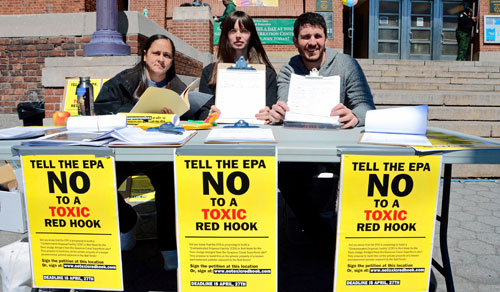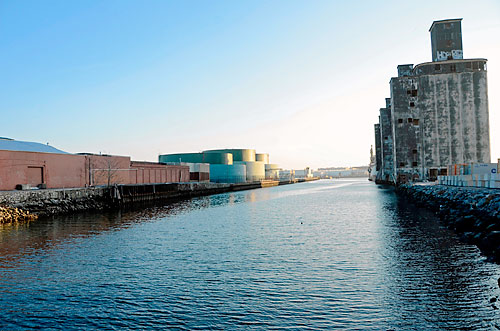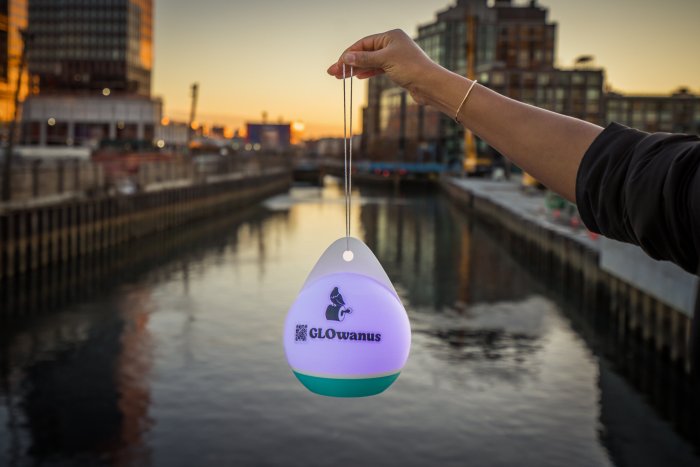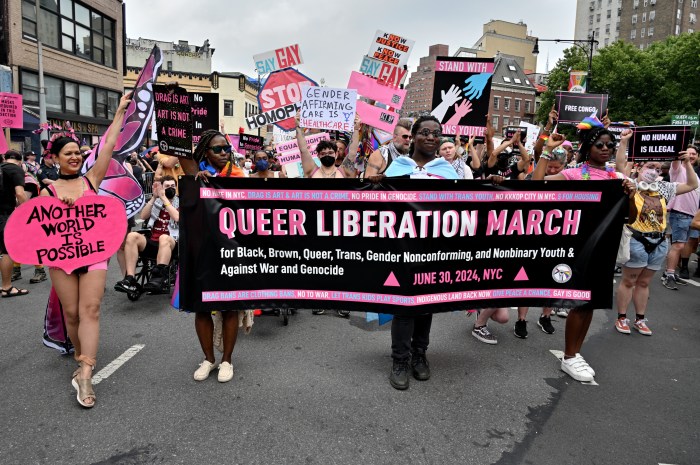A group of Red Hookers have made it crystal clear that they don’t want the federal government to store the sludge dredged from the toxic Gowanus Canal on their waterfront.
Residents working under the name “No Toxic Red Hook” are petitioning against a plan under consideration by the Environmental Protection Agency that would decontaminate some of the muck and use it to build a massive landmass on concrete tycoon John Quadrozzi’s property at the foot of Columbia Street as part of the agency’s half-billion dollar Superfund cleanup of the fetid waterway.
The feds claim it would be safe to construct a “confined disposal facility” that would turn the sludge into concrete and use it to permanently build out the waterfront at the Gowanus Bay Terminal and Gownaus Industrial Park, but neighbors are worried about their health, the risk of flooding, and the effects the operation would have on Red Hook’s bustling ball fields and pool.
“The community does not want to create more land from this contaminated sludge adjacent to one of the most heavily used recreation areas in New York City,” activists wrote on the online petition posted in March in a last push before the feds close the public commentary period later this month.
The Red Hook activists say they don’t oppose the polluter-funded cleanup of the waterway — just the proposal to process sludge in their community.
“This is almost the worst thing I can imagine for this neighborhood,” said Red Hook mom Carly Yates, a founder of No Toxic Red Hook who is worried about air pollution and fears that the site could become a permanent plant for treating toxic waste. “It’s disturbing — I don’t think that I can raise my daughter here if it were to be built.”
The sludge used to construct the landmass would be dredged from the least contaminated section of the canal-bed, which is south of Hamilton Avenue, moved by barge, and treated to remove hazardous toxins that may include coal tar and heavy metals, eliminating any health risks, feds claim.
“The materials would be rendered non-toxic and there would be a protective wall around the area where the materials would be placed,” said Superfund project manager Christos Tsiamis, who credits himself with coming up with on-site disposal option that he claims will shave $37 million from the project and create between 30 and 60 jobs over six years.
Workers would de-water the grime on Quadrozzi’s property, mix it with cement-like materials, and store it as stabilized concrete inside a bathtub-like fixture made of reinforced steel that would be buried in the Gowanus Bay and connected to his industrial complex.
Once the project is over, Quadrozzi can do what he wants with the land as long as he complies with certain federal guidelines.
Neighbors have blasted the plan due to reports the concrete titan owes hefty fees for illegally dumping into the Gowanus Bay — but Quadrozzi claims he does not face any fines and has paid off a settlement of $60,000 to the state several years ago after a dock collapsed and released sand, or what the state calls “plumage,” into the bay.
Quadrozzi alleges community activists are trying to undermine a safe and cost-effective clean-up proposal by pushing a petition that is laden with lies and wrongly refers to the “confined disposal facility” as a “contaminated disposal facility.”
“It’s intentionally misleading to scare the community into thinking that there would be no logical or beneficial reason to support this other than to create some land for some guy to do what he wants,” he said. “Anybody would read it and say of course I’m against this.”
The feds still have the option of shipping all of the sludge off-site to a licensed treatment facility if there is large community opposition to the construction of the concrete landfill by the end of the public commentary period, Tsiamis said at numerous public meetings. The state also has a say in the matter, according to agency officials.
The finalized plan for the cleanup of the canal will be released by the summer.
As of press time, the petition has 336 signatures.
The agency will accept written and public comments on the proposal until April 27. E-mail gowanuscanalcomments.region2@epa.gov or write to:
Christos Tsiamis, project manager
Central New York Remediation Section
US Environmental Protection Agency
290 Broadway, 20th floor
New York, NY 10007-1866
Reach reporter Natalie Musumeci at nmusumeci@cnglocal.com or by calling (718) 260-4505. Follow her at twitter.com/souleddout.





















